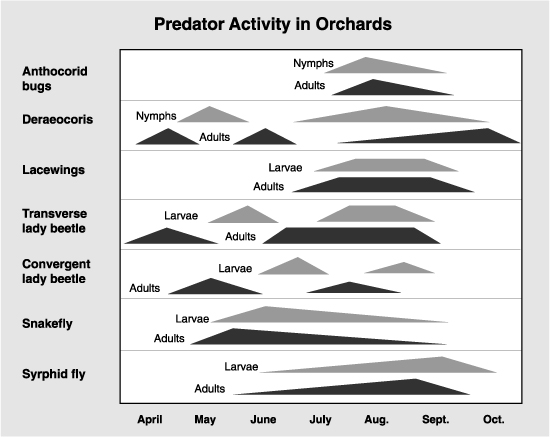Natural enemies are divided into two main groups: predators and parasites.
A predator lives by capturing and feeding on another species. Predators are usually larger and more powerful than their prey. Both adults and immature stages feed by devouring the prey or sucking the body juices. They can quickly destroy many pest insects or mites but may also require high pest populations to continue to survive.
A parasite lives in, on or with another organism and obtains food and usually shelter at the host’s expense. An example of a parasite is the flea that lives on a dog.
An insect that parasitizes other insects is most appropriately called a parasitoid. This term defines an organism that is parasitic in its immature stages but is free-living as an adult. Unlike a predator, a parasitoid kills its host over a long period of time and needs only one individual host to complete development. For example, a parasitic wasp might lay an egg in a caterpillar. The wasp larva hatches inside the caterpillar and feeds at first only on its fatty tissue, allowing the host to continue to grow and develop. As the wasp larva nears the end of its development, it feeds on the caterpillar’s vital organs, killing it. After leaving the remains of its victim, the wasp larva pupates and later emerges as an adult. Most parasitoids attack only one or a few host species. Predators generally attack a wider range of insects.
Monitoring
Natural enemies can be monitored while sampling for pests. For example, predatory mites can be counted in leaf brushing samples collected for spider mites, and parasitism of tentiform leafminer can be determined during field counts of leafminer densities. A beating tray sample is a useful way to estimate the abundance of several kinds of predators. Predators are usually sampled using a beating tray or counted while sampling for other pests. Their periods of highest activity are outlined in the following figure. Successive samples can show how pest populations are changing in relation to their natural enemies. New research is also showing ways to monitor natural enemies with attractive lures attached to sticky card traps.
Management
Use control tactics that are the least harmful to natural enemies. If insecticides must be used, select those that are known to be less toxic to predators and parasitoids. Spray when pests are most vulnerable and natural enemies are least vulnerable. For example, insecticides applied early in the growing season, before many natural enemies have become active or moved into the orchard, tend to be less disruptive than those applied later in the summer. Biological control can be promoted as an important tactic in pest management by using reduced rates where possible and spot treatments or delayed applications when it appears natural enemies might be able to provide control.
Natural enemies can be more easily established or reestablished in the orchard when natural habitat is provided near the orchard as a refuge. However, there is also the risk that natural habitats will be sources of pest infestations. Several species of predators and parasitoids can be bought for release in orchards.

